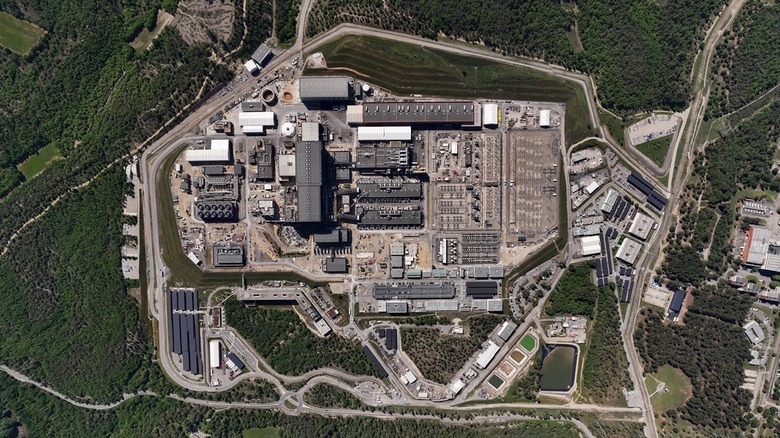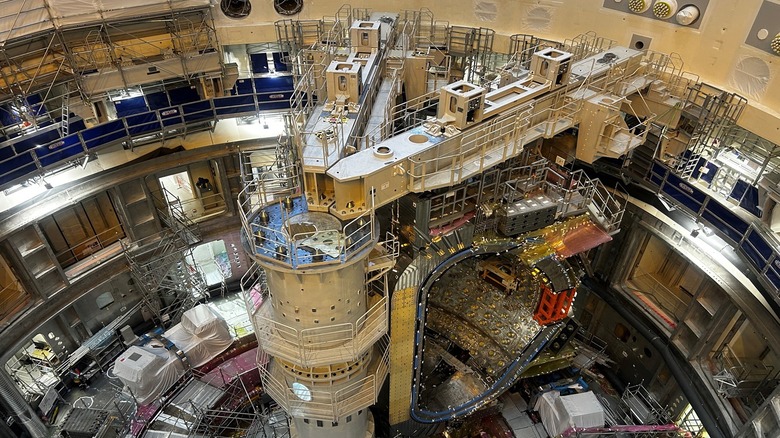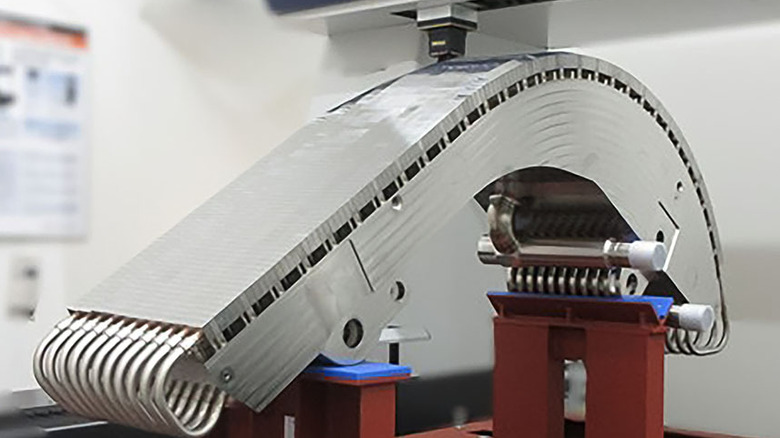The World's Largest Fusion Energy Experiment Is Entering A Critical Phase In The Project
A project of almost unimaginable scale is kicking into high gear in the south of France. The International Thermonuclear Experimental Reactor (ITER) is humanity's biggest and boldest attempt to essentially build an artificial sun on Earth. With this project, scientists hope to achieve nuclear fusion, which is the same process that powers the sun. This occurs in our star's core, where immense heat and strong gravity cause hydrogen isotopes to fuse together and form helium, releasing massive amounts of energy. Since we don't have the sun's gravity to help this process on Earth, we have to use even more heat. That's where ITER comes in.
The plan is to heat hydrogen isotopes called deuterium and tritium inside a donut-shaped vacuum vessel known as the tokamak, which is basically a chamber designed to hold plasma heated to an unfathomable 150 million degrees Celsius. If it works, we could get a clean power source that produces 4 million times more energy than burning coal and uses fuel that can be extracted from seawater.
Now, the project is entering its most critical construction phase yet, officially beginning the final assembly of its reactor core. Each step in the process requires precision and extensive planning, and this phase is no exception. The contract to oversee this monumental task was nabbed by American nuclear powerhouse Westinghouse Electric Company for the price of $180 million.
How the reactor core will be assembled
To assemble the reactor core, engineers plan to weld together nine enormous steel sectors that each tip the scales at roughly 400 tons. The process demands nearly exact precision, with alignment for some parts requiring a maximum uncertainty of just 0.25mm. Once these sectors are forged together, it will create a structure known as the tokamak. Since this tokamak deals with plasma heated to millions of degrees, it also needs to be heat-resistant so that its own walls don't melt in the process. At the same time, the heat needs to be contained inside the tokamak long enough so that the nuclear fusion can occur. To ensure this can happen, scientists are also constructing an "invisible shield" with a 3,000-ton magnet system.
At the heart of this system is the Central Solenoid, a massive 60-foot stack of superconducting magnets. Its final component was assembled in April, and the entire thing is now ready for installation in France. To be fit for a nuclear fusion reactor of this size, this has got to be a powerful magnet — and indeed, it's strong enough to lift an aircraft carrier. It generates a magnetic field around 280,000 times more powerful than Earth's own just to control the plasma inside.
Engineers also constructed the reactor's trash collector
While the main reactor vessel is being constructed, other critical pieces of the puzzle are also coming to fruition. On October 2, 2025, Mitsubishi Heavy Industries (MHI) and Japan's National Institutes for Quantum Science and Technology (QST) announced the completion of the first Outer Vertical Target, or OVT of the divertor. Essentially a sort of exhaust system, this apparatus work something like a trash collector, extracting impurities like helium ash and unburnt fuel from the plasma to keep the fusion reaction stable. The divertor sees some of the most extreme conditions in the whole machine, and it has to endure a heat load peaking at 20 megawatts per square meter. As such, the part is built from special materials like tungsten, which has a high melting point.
ITER isn't the only project like this going on: In February 2025, France set a world record for running a nuclear fusion reactor with the WEST program. However, what sets ITER apart from other systems is the scale at which it would operate. According to its website, ITER plans to have "five times the plasma volume of the largest machine operating today."
A process of this scale takes time, but ITER's journey hasn't exactly been smooth. The idea was first launched back in 1985, but construction only began in 2010. The budget ballooned from an initial $6 billion to well over $20 billion. Delays were caused by everything from the pandemic to components made in different countries not fitting together properly, and the start of deuterium-tritium operation is now planned for 2039. Still, this incredible project brings together 33 nations, including geopolitical rivals, for a common goal. It also echoes the U.S. government's renewed focus on nuclear energy.


